
How the Stratified Sampling Method Improves Election Accuracy
The stratified sampling method plays a vital role in ensuring election surveys are both accurate and representative. In a world where public opinion shapes national decisions, polling needs to reflect the true voice of the people. But how can researchers ensure that diverse opinions across demographics are included? That’s where this method comes into play.
Unlike simple random sampling, stratified sampling method divides a population into specific groups before selecting survey participants. This article will explain how this method works, why it’s especially important for political polling, and how it compares to other sampling types and techniques.
Understanding the Stratified Sampling Method
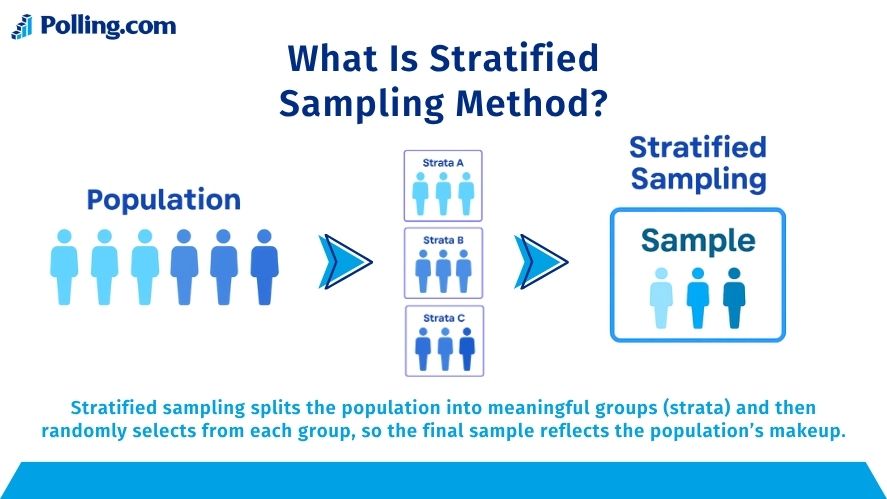
The stratified sampling method is a type of probability sampling where the population is divided into meaningful subgroups, or strata, before sampling. The main goal is to ensure every subgroup is properly represented in the final sample. These strata often include characteristics like age, race, gender, income level, or geographical region.
Instead of selecting participants randomly from the full population, researchers divide the population first, then randomly select individuals from each stratum. This method reduces bias and increases accuracy.
This is different from simple random sampling, which selects participants without considering subgroup representation. While random sampling is easier, it can miss underrepresented populations. Stratified sampling method, on the other hand, gives those groups a guaranteed voice.
Key Components of Stratified Sampling
To understand why this method works so well, it’s important to know its structure:
- Strata: These are subgroups based on shared characteristics like income level or political affiliation.
- Internal Homogeneity: Individuals within each stratum should be similar in ways relevant to the survey topic.
- External Heterogeneity: The strata should differ from each other to reflect the diversity of the total population.
By ensuring both internal consistency and external variation, the stratified sampling method leads to higher precision in survey results.
Common Types of Stratified Sampling
There are several variations of the stratified approach. Each serves a different purpose based on research goals:
Proportionate Stratified Sampling
In this version, each stratum is represented in the same proportion as it appears in the population. If 40% of the population is urban and 60% is rural, the sample maintains that same ratio.
Disproportionate Stratified Sampling
Sometimes, smaller subgroups are overrepresented to ensure enough data for analysis. For example, a small ethnic group might be 5% of the population but appear as 15% in the sample for deeper insight.
Optimal (Neyman) Allocation
This method assigns sample sizes based on both stratum size and variance. Strata with more variability get larger sample sizes to improve accuracy.
Each of these sampling types and techniques improves upon traditional methods by accounting for population diversity.
Why Stratified Sampling Method Is Crucial for Political Polls
Ensures Representation Across Diverse Groups
One of the strongest benefits of the stratified sampling method is its ability to capture opinions from all parts of the population. Political beliefs are influenced by race, age, income, education, and geography. If certain groups are left out, poll results can be misleading.
For instance, if young voters are underrepresented, predictions about election outcomes can be skewed. Stratified sampling guarantees their voice is included at the correct proportion.
Improves Accuracy and Reduces Sampling Error
The method also reduces sampling error by ensuring that each group is properly reflected in the sample. Since individuals are sampled within homogeneous groups, the variability within each group is lower. This leads to a lower overall margin of error.
By breaking the population into meaningful parts, the stratified sampling method helps generate more stable estimates, especially compared to other statistics sampling types.
Enables Subgroup Analysis
Election surveys often need to report data by subgroup, such as how men and women voted differently, or how opinions vary by age. Stratified sampling supports this by ensuring each subgroup has enough respondents to generate reliable results.
Without stratification, it’s easy for some subgroups to have too few participants to make statistically significant conclusions.
Enhances Credibility of Polling Results
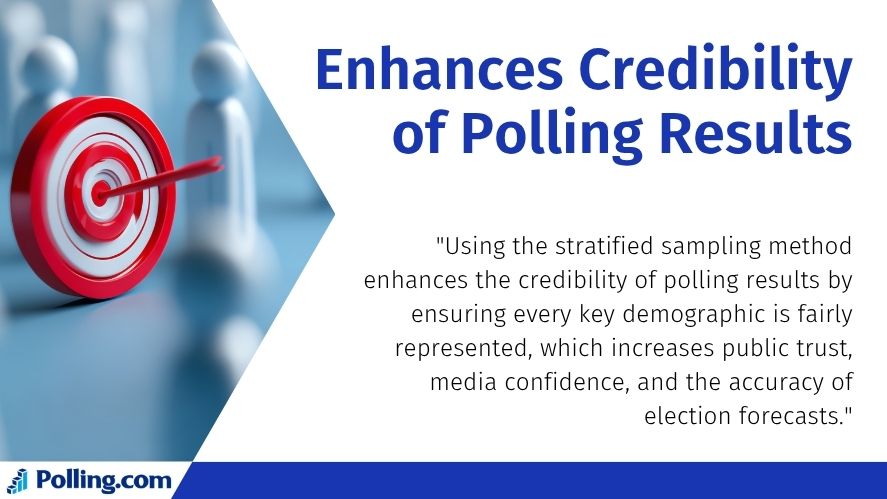
Credibility matters, especially in election forecasting. When pollsters use the stratified sampling method, they can confidently say their sample reflects the real electorate. This improves public trust, media credibility, and political planning.
Polling agencies like Polling.com have built a reputation for reliable results by implementing detailed polling.com methodology and polling.com data sampling methods based on stratified approaches.
Step-by-Step: Designing a Stratified Sampling Political Poll
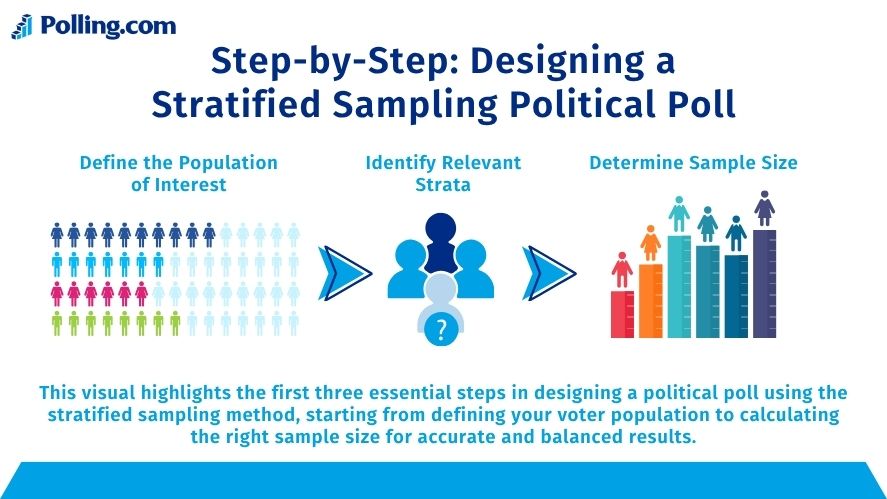
Let’s break down how to actually design a poll using the stratified sampling method.
Define the Population of Interest
Start by clearly defining who you’re studying. In election surveys, this often includes:
- Registered voters
- Likely voters
- All eligible citizens
Precision here is key. You must know who you’re trying to represent to design an accurate sampling strategy.
Identify Relevant Strata
Next, determine the characteristics that divide your population. Common variables include:
- Age groups
- Gender
- Region (state, urban/rural, district)
- Race and ethnicity
- Political party affiliation
The goal is to choose variables that affect how people vote. Stratifying based on hair color or height wouldn’t help unless that somehow influenced voting behavior.
Determine Sample Size
Once you have strata defined, decide how many total people you’ll need in your sample. This depends on your margin of error, confidence level, and budget.
A large enough sample ensures you can make accurate predictions even at the subgroup level.
Allocate Sample to Each Stratum
This step depends on the type of stratified sampling you choose.
- Use proportional allocation to reflect real-world population percentages.
- Use disproportionate allocation to ensure small but important subgroups get attention.
Oversampling is common in election polling, especially for minority or swing-voter groups.
Conduct Sampling Within Strata
Once you’ve divided your population, select individuals randomly within each stratum. This can be done using:
- Simple random sampling
- Systematic sampling
This dual approach combines the benefits of stratified sampling method and other sampling types with examples like random or systematic techniques.
Prepare for Fieldwork and Data Collection
With your sample ready, it’s time to collect responses. This includes:
- Writing unbiased survey scripts
- Choosing a survey mode (phone, online, in-person)
- Training your interviewers
Each detail influences data quality and reliability.
Weighting and Post-Stratification Adjustments
Why Weighting Is Necessary
Even with a strong sampling plan, you may get uneven responses. Some groups are harder to reach than others. Weighting corrects for this imbalance so the final results still reflect the population accurately.
This is especially important when you’ve used disproportionate stratified sampling or experience high nonresponse rates.
Common Weighting Techniques
Pollsters use a few standard techniques to balance samples:
- Raking: Adjusts weights so sample margins match known population margins across several variables.
- Iterative Proportional Fitting: A more advanced form of raking used in large-scale surveys.
These ensure the final weighted sample aligns with census or voter registration data.
Matching Survey Data to Census Benchmarks
Weighting is most accurate when you compare your sample to trusted benchmarks. This often includes data from:
- U.S. Census Bureau
- State voter files
- Exit polls from prior elections
Using reliable benchmarks ensures your weighted data mirrors the actual population.
Post-Stratification vs. Pre-Stratification
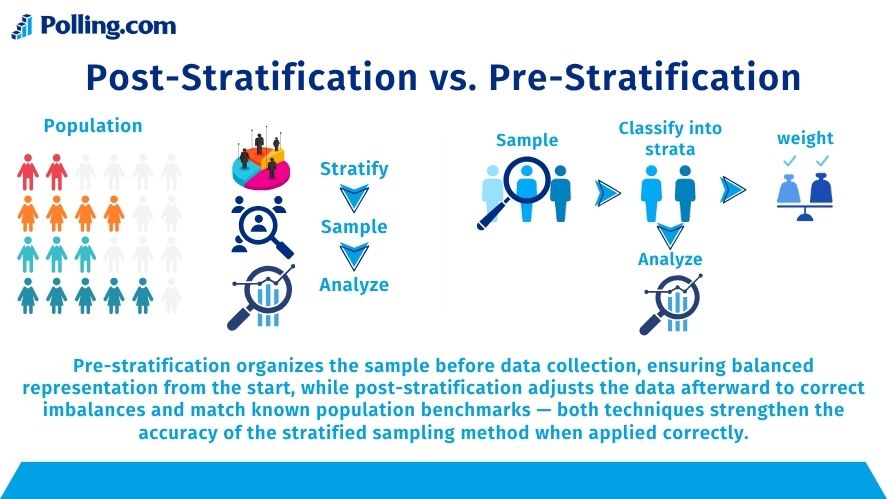
Both techniques have benefits:
- Pre-stratification: Involves building strata before sampling
- Post-stratification: Adjusts weights after sampling
Combining both often yields the best results. Pre-stratification ensures you start with the right groups; post-stratification corrects for issues that arise during data collection.
Weighting and Post-Stratification Adjustments (Continued)
The Impact of Weighting on Final Poll Accuracy
When used correctly, weighting brings your sample into balance with the known population. However, poor weighting practices can make the data worse. Overweighting small subgroups or using incorrect benchmarks may distort the results. Therefore, researchers must track weighting factors and apply them with caution.
Organizations like Polling.com use advanced data science tools to ensure that weighting strengthens rather than weakens survey outcomes. Their built-in weighting engines apply tested models, making the stratified sampling method even more powerful.
Challenges and Limitations of the Stratified Sampling Method
While the stratified sampling method offers many benefits, it also introduces some challenges that researchers need to handle carefully.
Defining Strata Can Be Complex
One of the first challenges is choosing which characteristics to use for stratification. If the variables are too broad, they may not create useful distinctions. On the other hand, if the categories are too specific, the strata may become too small to analyze effectively.
For example, stratifying by political party makes sense in most political surveys. However, dividing respondents by party, age, income, education, and location all at once may produce too many combinations to manage.
Overstratification and Sample Dilution
Creating too many strata can lead to tiny subgroups with too few participants to analyze. This causes high variance and reduces statistical power. Even though the stratified sampling method aims to reduce error, overstratification can create the opposite effect.
To prevent this, researchers must balance the desire for detailed analysis with the need for robust subgroup sizes.
Nonresponse Within Strata
Even when strata are well-designed, you may face low response rates from certain groups. For example, younger voters often respond at lower rates than older ones. If enough people within a stratum do not respond, the group may not be accurately represented.
This issue affects all types of sampling in survey research, but it’s particularly important in stratified designs because each stratum plays a key role in the final outcome.
Cost and Operational Complexity
Another limitation of the stratified sampling method is the added cost and effort. Managing separate lists, quotas, and sampling procedures for each stratum takes time and resources. For phone or in-person surveys, this can lead to longer timelines and higher operational costs.
Compared to other sampling types and techniques, stratified sampling often demands more from the research team.
Impact on Variance Estimation
When data are collected using a complex design like stratified sampling, variance estimation requires special analysis. Standard errors, confidence intervals, and test statistics must account for the design. Failing to do this may lead to misleading conclusions.
That’s why survey analysts often use specialized statistical software to analyze data from stratified sampling method polls.
Real-World Applications and Examples
To fully understand the value of the stratified sampling method, let’s look at how it’s applied in real-world election polling.
National Election Polls
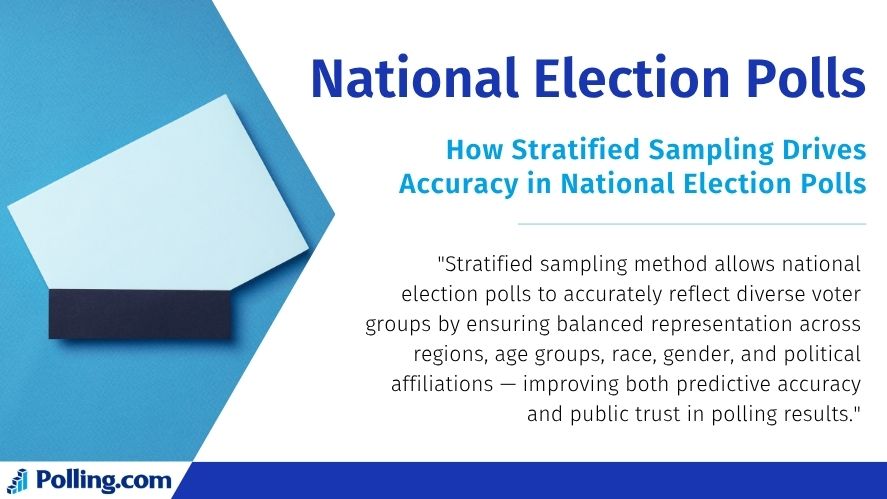
Large national polling firms use stratified sampling to ensure their surveys represent all regions, races, and political affiliations. They stratify by state, urban vs rural areas, age group, and other demographic features.
For instance, a poll may include 500 respondents from each of the major states and oversample swing states. Then, responses are weighted to reflect the national population.
This approach allows for national insights while maintaining strong subgroup data. Polling.com surveys apply these same principles, especially when delivering forecasts ahead of national elections.
State-Level and Local Polls
When polling at the state level, geographic stratification becomes even more important. Populations in urban and rural areas often vote very differently. For example, a poll in Texas may divide respondents into groups from major metros (like Dallas or Houston) and rural counties.
Without geographic stratification, the results could misrepresent state-level preferences.
Exit Polling Using Stratified Precinct Sampling
Exit polls often use stratified sampling method at the precinct level. Pollsters identify precincts that represent various voting blocs, then survey voters after they cast their ballots. This allows for detailed analysis by race, gender, and region.
In this case, the sampling unit is not the individual, but the voting location. The approach ensures diverse precincts are included in the final report.
Comparative Case Study: Simple Random Sampling vs Stratified Sampling Method
Let’s compare outcomes between two methods. Suppose researchers use simple random sampling to survey 1,000 voters. If most of the respondents are older adults from urban areas, the results may not reflect younger or rural voters.
Now imagine using the stratified sampling method with the same sample size. By stratifying by age and geography, the final sample includes proportional representation from all key voter groups. The findings will be more accurate and more useful for campaign strategies.
These real-life examples show why many polling experts prefer stratified sampling method over other sampling types.
Best Practices for Implementing the Stratified Sampling Method
Using the stratified sampling method correctly takes planning and discipline. Here are best practices that help ensure success.
Use High-Quality Population Benchmarks
Stratification only works if you know the true population structure. Use data from the U.S. Census, state voter files, or trusted demographic studies to define your strata.
Pretest Strata Segmentation
Before launching your full poll, test your stratification logic with a pilot survey. This can uncover any issues with grouping or sampling procedures early in the process.
Apply Proper Weighting Procedures
Even after carefully stratifying your sample, response rates can vary. Always apply weights to match your final sample to known benchmarks. This ensures both coverage and accuracy.
Be Transparent in Methodology Reporting
Explain your approach in detail. Voters, journalists, and political analysts trust polls more when the methods are transparent. Report how you defined strata, how you sampled, and how you weighted responses.
Transparency also sets your survey apart from low-quality polls that rely on unclear or biased methods.
Use Expert Tools Like Polling.com’s Survey Platform
Platforms like Polling.com simplify the entire process. You can build demographic targets, apply stratified logic, and export weighted data quickly. With tools like automated weighting, stratification templates, and visual dashboards, Polling.com supports both small and large pollsters.
For those new to survey research, this platform reduces the complexity of designing effective samples.
The Polling.com Advantage
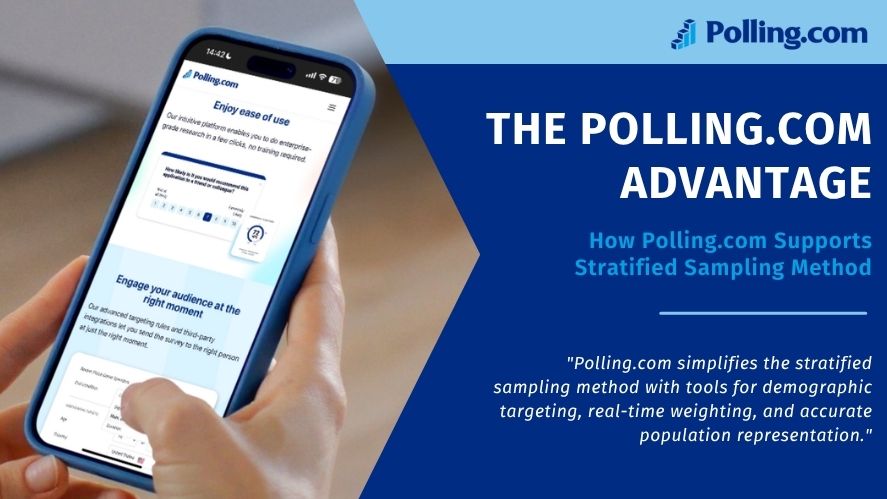
How Polling.com Supports Stratified Sampling Method
Polling.com offers built-in support for stratified sampling, allowing users to:
- Define custom strata by age, race, geography, and more
- Select from preset demographic templates based on U.S. Census or voter file data
- Conduct polling.com surveys with full tracking and analytics
Easy Survey Setup with Demographic Targeting
Users can design their surveys using point-and-click interfaces to target exact strata. No coding or manual sampling lists required.
This makes polling.com methodology highly accessible to beginners, while still offering the power needed by advanced researchers.
Built-In Weighting and Data Quality Tools
The platform automatically applies weighting adjustments during or after data collection. This includes:
- Response-based weighting
- Raking based on multiple demographic axes
- Nonresponse bias detection
Custom Political Polling Dashboards and Export Features
Polling.com lets political strategists view responses in real-time, filter by strata, and generate visual reports. You can also export the full weighted dataset for custom analysis in Excel, SPSS, or R.
Whether you’re polling a national audience or a swing district, Polling.com data sampling methods help ensure your survey reflects the voters who matter.
Why Political Strategists Trust Polling.com
Campaign managers and political consultants turn to Polling.com because it delivers accurate, transparent, and easy-to-use polling tools. With built-in support for the stratified sampling method, it removes the guesswork from sampling and increases the credibility of every poll.
Conclusion
The stratified sampling method is one of the most powerful tools available to pollsters and survey researchers. By dividing the population into logical, meaningful groups and ensuring balanced representation, this method improves the accuracy, reliability, and credibility of election polling.
In this article, we explored:
- What stratified sampling method means and how it works
- How it compares to other sampling types and techniques
- Why it’s essential in political surveys
- Step-by-step design and real-world applications
- Best practices for success
- How Polling.com simplifies and enhances the entire process
With rising demand for accurate public opinion data, especially in elections, the stratified sampling method stands out as a gold standard. If you’re ready to conduct surveys that truly reflect your target population, consider leveraging Polling.com’s methodology and tools today.
Accurate polling doesn’t have to be complicated — it just needs the right method.
